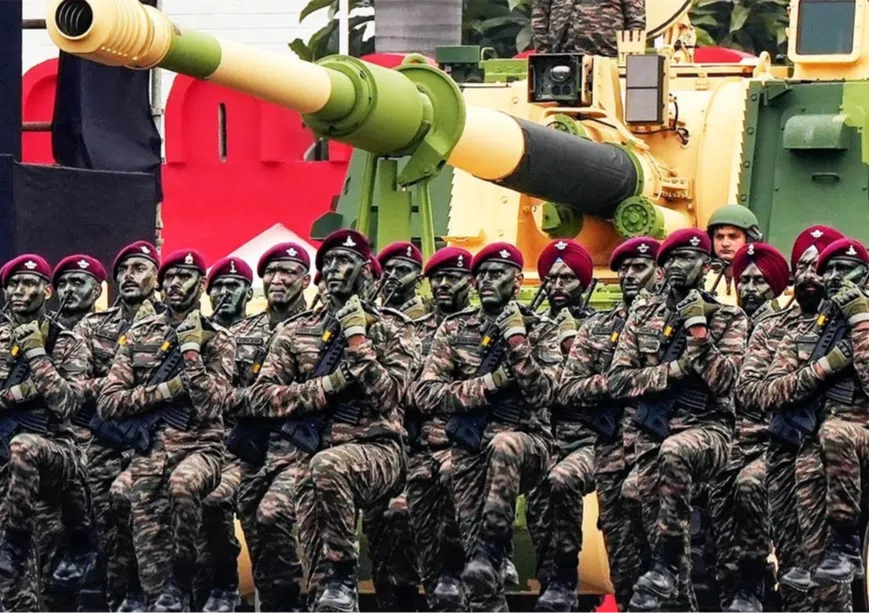
In response to the changing nature of warfare and geopolitical dynamics in the region, the Indian Army (IA) is gearing up for a substantial modernisation effort. With a current strength of 1.4 million personnel, the army faces several challenges due to the unpredictability of the nature of warfare and its extensive role in defending conventional and unconventional security challenges. At the annual Army press conference held recently, the Chief of Army Staff (COAS), Manoj Pande, said that 2024 will be the year of technology absorption for the Indian Army. As compared to the earlier proclamation of observing the year 2023 as the ‘year of transformation’, the new emphasis on technological absorption is a quantum leap in the right direction. This statement can be seen as a supplement to last year's commitment to transformation. In other words, the 2024 pledge is a continuation and upgradation of the ‘transformation’ commitment.
As compared to the earlier proclamation of observing the year 2023 as the ‘year of transformation’, the new emphasis on technological absorption is a quantum leap in the right direction.
The IA is set to integrate drones and counter-drone systems across its infantry, artillery, and armoured battalions, reflecting a forward-looking stance. Additionally, at the structural level, the establishment of Command Cyber Operations Support Wings (CCOSWs) emphasises a commitment to enhancing cyber capabilities. A reorientation of its crucial arms, such as artillery, coupled with the infusion of fresh human resources through Agniveer recruits, highlights the army's adaptability to emerging threats. Further, the army is expanding its human resources pool by creating specialist officers through the Territorial Army, including cyber experts through civil-military infusion. The focus on technology as a catalyst for transformative change is evident in plans to handle drones and counter-drone systems seamlessly within existing structures.
Communication takes a pivotal role with the induction of 2500 Secure Army Mobile Bharat Version (SAMBHAV) handsets, showcasing the army's self-reliance in technology. The ambitious goal of distributing 35,000 SAMBHAV handsets to officials handling sensitive assignments underscores the commitment to secure and efficient communication channels. This comprehensive strategy aligns human capital with the demands of modern warfare, positioning the Indian Army for technological absorption in 2024.
A reorientation of its crucial arms, such as artillery, coupled with the infusion of fresh human resources through Agniveer recruits, highlights the army's adaptability to emerging threats.
Why is 2024 crucial for the Indian Army?
The significance of 2024 for the IA lies in the significant changes occurring globally that is shaping the very nature of warfare. As nations undergo military modernisation, driven by larger geopolitical shifts, advanced technologies such as lethal autonomous systems, artificial intelligence, hypersonic weapons, directed energy weapons, biotechnology, and quantum technology are becoming pivotal in warfare. For India, China's expanding capabilities, particularly near Indian borders, especially post Galwan clashes, employing subtle ‘grey zone’ tactics, pose a significant challenge. In his recent address, the COAS said that “Grey zone aggression is increasingly becoming a preferred strategy of conflict prosecution, with its scope enhanced by technological advancements.” The COAS indirectly pointed out grey zone tactics employed by both China and Pakistan. Elaborating further COAS emphasised that such aggression requires self-sufficiency in critical defence technologies and investment in R&D.
In addition to the looming threat from China, India currently grapples with a new hybrid form of militancy originating from Pakistan that exists inside and along the borders. The rise of ‘hybrid’ militancy in the Kashmir valley, a blend of conventional and unconventional threats, introduces disruptive elements both along and within the borders.
The COAS said that “Grey zone aggression is increasingly becoming a preferred strategy of conflict prosecution, with its scope enhanced by technological advancements.”
Responding to these challenges, the IA must not only replace ageing capabilities and armaments with technologically advanced alternatives but also enhance tactical capabilities, emphasising niche technologies like unmanned aerial vehicles, anti-drone systems, and dedicated units specializing in Electronic Warfare. Implementation of sophisticated surveillance technologies, including satellite imagery, drones, and advanced sensors is critical. Cybersecurity measures play a crucial role in protecting the Army's own critical infrastructure from digital threats associated with grey zone tactics.
A marathon rather than a sprint
Embracing the latest advancements in warfare technology should be a marathon rather than a sprint for the Indian Army. While the buzz around cutting-edge military tech is undeniable, the process of implementation and adoption is a gradual one that unfolds over time. Keeping pace with the ever-evolving landscape of military technology is an ongoing challenge that demands a long-term commitment. The absorption of technology by the IA necessitates sustained efforts, complemented by a military ecosystem that actively promotes the seamless integration of technology into its operational framework.
The army's engagement with civilian spaces, particularly academia and industries, for innovative solutions to operational and tactical challenges is commendable with the establishment of initiatives such as Innovations for Defence Excellence (iDex), yet there is a need for systematic and long-term initiatives within a framework that is not ad-hoc and promotes strong and independent defence industrial base that in pace with needs of the IA. Recognising that technology proficiency requires specific training and education, the establishment of specialised and separate cadres of human resources emerges as a strategic investment that will yield fruitful results in the long run. Recently, the Indian Army introduced a new policy allowing Lieutenant Colonels specialising in technologies like AI, robotics, and drones to stay in their field on promotion to Colonel, deviating from the standard practice of moving to command roles. This applies to other niche areas as well. However, these officers will forgo command assignments and certain career courses. The policy aims to promote specialisation within the Army, but officers choosing this path won't be eligible for future promotions. The policy will be reviewed after three years to assess its impact.
Recognising that technology proficiency requires specific training and education, the establishment of specialised and separate cadres of human resources emerges as a strategic investment that will yield fruitful results in the long run.
While adoption and adaptability to technological changes are critical, such transformation must be reflected in the doctrinal thinking of the IA. The last land warfare doctrine that was released in 2018 and read in conjunction with the Joint Doctrine of the Indian Armed Forces 2017 highlights the non-contact and hybrid nature of challenges for India. However, remarkable changes in the contours of warfare have happened post the last doctrinal assessment that particularly focused on changing the contours of land warfare in the Indian context. The Galwan clashes and the Russia-Ukraine War necessitates IA to adopt lessons learnt in the regional and global context of warfare and technology. While such periodic assessment of doctrine is pertinent, what is more important is a doctrine that drives technological advancement and adaptability rather than technology at perusal driving the doctrine.
Conclusion
The IA’s shift towards technology absorption in 2024 raises both promise and scrutiny. While the emphasis on integrating advanced tools like drones and cybersecurity reflects a proactive response to evolving challenges, the transition from a broader transformational agenda warrants careful consideration. The urgency brought by global military trends and the proximity to expanding Chinese capabilities underscores the need for a swift technological adaptation. However, the potential drawbacks, such as the inherent complexities of technology integration and the long-term commitment required, should not be underestimated. As the army treads this path, balancing tradition and innovation, the critical eye must remain vigilant, assessing the outcomes and ensuring that the pursuit of technological prowess aligns seamlessly with national security imperatives. The success of this strategic shift will depend not just on the adoption of technology but on the army's ability to navigate the complexities and challenges that come with such a transformative journey.
Ankit K is New Delhi-based analyst who specialises in the intersection of Warfare and Strategy.
The views expressed above belong to the author(s). ORF research and analyses now available on Telegram! Click here to access our curated content — blogs, longforms and interviews.




 PREV
PREV


